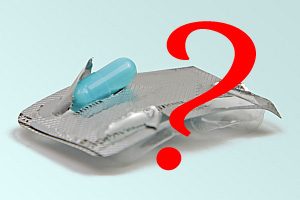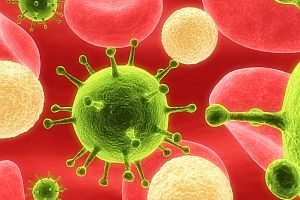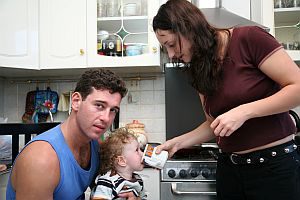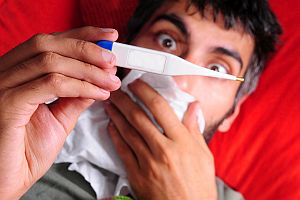Detox Immune-Boosting Soup
[amd-zlrecipe-recipe:42]
[amd-zlrecipe-recipe:42]
This is not a short video but it has such important information! We hope all of you will take the time out of your busy lives to watch it! We will continue to share this series of videos as it is released. The information shared here is vitally important to understand for positive physical and mental health!
Maybe it’s just wishful thinking, but many moms and dads believe that having a young child or two around the house boosts their immune system. It’s easy to see why this idea has some popular appeal. After all, young children typically have lots of contact with other young children, often in environments where lots of germs can be spread. They then bring these same germs home, where parents’ immune systems need to fight them off over a sustained period of time. The thinking goes that this, in turn, helps make parents more resistant to them.
But what does the science actually say about this? Although there is at least one strong study and a lot of related or anecdotal evidence that suggests that the idea may be sound, more research needs to be done to see if this theory is valid.
The “strong study” is from Norway, and was published in the journal Science & Medicine. It’s important to note that the study did not specifically evaluate the immune response of parents and non-parents. Rather, this particular research was aimed at understanding the relationship between parenthood and overall health. The investigators looked into detailed medical records of more than 1.5 million men and women born between 1935 and 1968, and found that there was a strong negative correlation between being a parent and the risk of developing cancer, heart disease, becoming an alcoholic, and even dying in a car crash. The study found that the people most at risk of dying from any of these causes were those who were childless. The researchers theorized that this may be because the individuals felt less of a need to take care of their health.
Fascinatingly, the study also found that the positive health benefits or parenthood seemed to depend on the numberof children. Having only one child or having more than three children actually slightly increased the risk of dying from any of these factors, whereas having two children was “just right.” As researcher Emily Grundy of the London School of Hygiene & Tropical Medicine, says: “Four-plus children might have adverse effects arising from stress, socio-economic disadvantages and lifestyles, off-setting, or even outweighing, social benefits of parenthood.”
In terms of other evidence, the strongest suggestions that having children might strengthen their parent’s immune system come from related studies that have consistently shown that having pets in the home strengthens and builds the children’s immune systems and helps to keep them healthy. For example, a 2012 study from the journal Pediatricsshowed that children who lived with dogs and cats during the first year of life tended to be significantly healthier than those who did not. The researchers theorized that the pets exposed children to a wide variety of “good germs,” some of which are beneficial for developing immunity to the “bad germs.” We may be able to infer that parents might also benefit from being exposed to a variety of germs, both from the pets and from their own children, as children pick them up at school and bring them home.
There is certainly anecdotal evidence of the latter to be found in the “common wisdom” imparted to people becoming new kindergarten and elementary school teachers. When one woman started teaching in California, her school board warned her that she should probably plan her finances for the first year of teaching based on being out sick more than her allotted number of “sick days,” and thus not being paid for them. The woman, who had always been remarkably healthy, laughed at this advice, but then spent 25% of her first year at home sick, because of all the germs she picked up from kids in the classroom.
However, this same schoolteacher rarely ever got sick again. Her exposure to a wide variety of germs transmitted by the kids did seem to boost her immune system over time, and enhanced her ability to be exposed to them in the future without getting sick herself. We can possibly infer that the same thing happens with small children in the home—they pick up germs at school and bring them home where the parents are exposed to them. This exposure then buildsimmunity over time rather than diminishing it. Dr. Jordan S. Orange, chief of immunology, allergy and rheumatology at Texas Children’s Hospital explains the simple mechanics of this “early exposure” process this way: “When you get it [immunity], you have it. So, if you get it earlier, you’re going to be immune earlier.”
Related studies have indicated that many people feel happier when they have kids. If this is actually true, then their positive mental state can also certainly contribute to staying healthy. Besides, as all parents know, there are so many other joys associated with having kids that even if there aren’t a huge number of studies proving that they keep parents healthier, they’ll feel healthier.
 10 Health Benefits of Onions
10 Health Benefits of OnionsOnions are considered one of the world’s healthiest foods and given that there are varieties of onions, how you use them could be different each time! Grown all over the world, the first record of using onion for health purposes and healing was in the 17th century. The truth is, onions are therapeutic, which is lucky, seeing as Americans eat over 20 pounds of onion per capita, per year. Want to know what is so good about them? Read on!
Onions contain powerful antioxidants. Antioxidants are flavonoid compounds, which delay or help repair oxidative damage to different cells and tissues in the body. Eating onion regularly can also protect the body and help regenerate the powerful antioxidant vitamin E, which the body needs as a fat-soluble nutrient. Plus, onion contains allicin. Allicin, a plant derived nutrient, is a killer of various viruses and bacteria, which means it’s a good thing if you eat some raw onion when you feel the onset of a cold or flu, this way the immune effect will be the strongest.
When inflammation in the body is working properly, it fights against the disease or protect a wound, gets rid of the virus and then leaves the body, It’s when it goes a bit wrong and doesn’t leave the body, that your immunity is compromised. Naturally anti-inflammatory, onions can help fight inflammation, when the inflammation is the problem. Quercetin, found in onion, has proven to inhibit inflammation-causing leukotrienes and the prostaglandins and histamines that are in rheumatoid arthritis, and osteoarthritis. So it can help inflamed joints and chronic inflammation pain.
There has been extensive research into how onions affect blood sugar. This is good news for the 29 million people in the United States who have diabetes. The tests showed that people, who were diagnosed with type 1, and those with type 2 diabetes, had a lower blood sugar level (glucose reading) after eating onions, and it remained low for up to four hours after eating. This means onion could be very helpful in the management of diabetes. This is because of the sulfur compounds in onions that work to increase insulin production and, therefore, lower glucose levels.
Onions are the richest natural sources of Quercetin you can find. Quercetin is a powerful antioxidant flavonoid that has been linked to inhibiting certain kinds of cancers. Research and clinical trials have been undertaken to learn more about the effect of the quercetin in onions have on cancer, and it is not considered a drug to combat cancer. Eating onions will simply give you many good benefits that could lead to preventing cancer, because of the dietary source of quercetin it contains.
These antioxidants such as quercetin, work to thin the blood and ward off blood clots. This is particularly the case if you eat raw onion. Raw onion lowers the chanced of bad cholesterol (LDL) which keeps hearts healthy. Not just for lowering your cholesterol, eating onions regularly can also lower blood pressure, and keeps the risk of heart attack and heart diseases or heart risks low. Heart risks including arterial hardening and gallstones. Any foods that support heart health are usually recommended by any heart foundation and are part of a balanced diet.
Onions are considered one of the world’s healthiest foods, not surprising as they contain multiple vitamins and minerals. First up there is a rather decent amount of vitamin C in onions, and we all know vitamin C is good for you. Onions also contain vitamin B6. B6 is great for red blood cell formation, Potassium, which is important for low blood pressure, and general heart health and Folate B vitamin bodies need for metabolism and cell growth. Not only the above but they are also a good source of dietary fiber, calcium, iron, low sodium and have no fat.
Free radicals are molecules that attack healthy cells in the body. These free radicals want to steal all the good stuff from healthy cells, like electrons and rebalance, which cause damage to the good cells, this, in turn, affects the body in regards to aging and deterioration. And if your body is overrun with free radicals, oxidative stress is created. You can combat free radicals by eating foods that are high in antioxidants. Onions do this by eliminating free radicals, they even search them out and kill them, and therefore, reducing the aging process and your risk of developing other related diseases.
You can make your cough syrup at home from onions, and it does, in fact, taste better than it sounds, and some may say, better than over the counter cough syrups. Using a red or yellow onion, slice it evenly and place at the bottom of a jar. Pour a layer of honey over it, then repeat layering onion slices, and honey until you are out of the onion. (You can use raw or brown sugar instead of honey if you like but it will be much sweeter) Cover the jar tightly and let it sit overnight. After up to 12 hours the liquid in the jar becomes your cough syrup. Take one spoonful, three times an hour. This concoction will begin to break up and mucus, its natural antibiotic properties begin to take effect and the honey works to soothe the throat.
The soothing properties of applying a freshly cut slice of onion directly onto a wasp or bee sting can immediately begin to take effect. The enzymes in onions can help break down the compounds found in the venom of a bee or wasp sting. This is what causes the inflammation and subsequent pain and even swelling. Applying onion can reduce all of these things initially. It also helps in the length of time the sting takes to heal. This ‘home remedy’ was once thought to be an old wives tale. Now it is commonly known to be correct, and more importantly, actually work!
Western yellow onions and shallots are considered the healthiest because of their phenolic and flavonoid content. In general, consuming these versatile vegetables is only ever a good thing, no matter what kind of onion. These two kinds of onions are both from the allium family, and they can be pretty easily interchanged in recipes. They have a slightly different taste in regards to pronounced sweet flavor (shallot) and bite (yellow onion). That does not make them unusable. If anything, it makes them more desirable to the palate, and to the health system.
Today’s article was written by Charmaine and is shared from the following website: http://health.facty.com/food/nutrition/10-health-benefits-of-onions/?utm_source=bing&utm_medium=c-search&utm_term=health%20benefits%20of%20onions&utm_campaign=f-h-10-health-benefits-of-onions&msclkid=57e38f7f3d051891d8f5d5c259ba940f
We hope you will watch this video. The work of Dr. Masaru Emoto is a vibrant reminder of the influence that our thoughts and the kind of music we surround ourselves with has on our health and well-being. Remember…our bodies are largely made up of water!
 With the huge rise in the use of antibiotics over the past 70 years, some pathogens are now becoming resistant to the drugs that once easily eradicated the illnesses these pathogens cause. People who become infected with one of these drug-resistant organisms are at increased risk for longer, more costly hospital stays and are more likely to die from their infection.
With the huge rise in the use of antibiotics over the past 70 years, some pathogens are now becoming resistant to the drugs that once easily eradicated the illnesses these pathogens cause. People who become infected with one of these drug-resistant organisms are at increased risk for longer, more costly hospital stays and are more likely to die from their infection.
Medical researchers and public health experts believe there are a few different causes for the emergence of drug-resistant bacteria. These include the widespread use of antibiotics in animals as well as and the overuse and misuse of antibiotics in humans.
Cattle, pigs and chickens are routinely given antibiotics to prevent illness and increase weight gain. However, 55 outbreaks of foodborne illness over the past 40 years have been caused by antibiotic-resistant pathogens. New York Congresswoman Louise M. Slaughter, a microbiologist, said “We have evidence that the practice of overusing antibiotics in food-animals is ruining these drugs’ effectiveness, and every day that the government stands idly by, we move closer to the nightmare scenario where routine infections can no longer be cured with antibiotic treatment.” Slaughter has proposed Preservation of Antibiotics for Medical Treatment Act (PAMTA), which would ban the use of 8 major classes of antibiotics from use on healthy animals, with exceptions only for animals who are actually ill.
Doctors are often pressured to prescribe antibiotics for illnesses that antibiotics are ineffective at treating, such as viruses. Parents of sick children have been shown to be particularly bad about exerting pressure on their doctor to give their children an antibiotic, no matter what the illness actually is. In the case of viruses (such as the one that causes the common cold, most coughs and the flu), antibiotics are useless. Antibiotics work against bacteria such as streptococcal bacteria (strep throat) and staphylococcal bacteria (skin infections). The bacterial infections most in danger of becoming resistant to all antibiotics include anthrax, gonorrhea, group B Streptococcus, Klebsiella, Methicillin-resistant Staphylococcus aureus (MRSA), Streptococcus pneumoniae, tuberculosis, typhoid fever, vancomycin-resistant enterococci (VRE) and the antimicrobial-resistant staph bacteria VISA and VRSA.
The best way to help reduce the spread of drug-resistant illnesses is to refrain from pressuring your doctor to prescribe antibiotics when it is not appropriate, and when antibiotics are called for, to take them according to directions. Be sure to complete the full course of the antibiotic regimen prescribed, even if you are feeling well again. If you don’t, some bacteria may linger and develop a resistance to the drug you are taking, potentially making that antibiotic ineffective for you in the future. Do not skip any doses, share your antibiotics with anyone else, or use antibiotics that have been prescribed for someone else.
In general, the symptoms of a virus disappear in about a week or so. In contrast, bacterial infections tend to linger. So if you have been feeling ill for more than two weeks, consult with your physician to see if antibiotics may be appropriate for treating of your illness. If not, he or she can prescribe other effective ways to treat your condition.
 People are becoming increasingly aware of the dangers that can result from the overuse of antibiotics. When antibiotics were first discovered in the early 20th century, researchers believed that they had found the key to conquering many deadly diseases. Since that time, antibiotics have certainly helped to cure diseases that once wiped out large parts of the population. However, there is growing evidence that antibiotics are now being used too frequently, and that they are often being used in inappropriate circumstances. This has led to many previously curable diseases becoming antibiotic-resistant, which means that a cure now requires the use far stronger antibiotics. In fact, some diseases have now become resistant to nearly all antibiotics. It is obvious that if antibiotic use continues in this way, we may have a major health crisis on our hands.
People are becoming increasingly aware of the dangers that can result from the overuse of antibiotics. When antibiotics were first discovered in the early 20th century, researchers believed that they had found the key to conquering many deadly diseases. Since that time, antibiotics have certainly helped to cure diseases that once wiped out large parts of the population. However, there is growing evidence that antibiotics are now being used too frequently, and that they are often being used in inappropriate circumstances. This has led to many previously curable diseases becoming antibiotic-resistant, which means that a cure now requires the use far stronger antibiotics. In fact, some diseases have now become resistant to nearly all antibiotics. It is obvious that if antibiotic use continues in this way, we may have a major health crisis on our hands.
The first thing to be aware of is that antibiotics are not effective in the treatment of viruses. They only treat bacterial infections, certain fungal infections and parasites. For diseases such as the common cold, flu or bronchitis, antibiotics are completely ineffective and their use in cases such as these will only contribute to the development of antibiotic-resistant bacteria. You should not ask your doctor to prescribe antibiotics if you have a sore throat or the stomach flu, for instance. According to the Centers for Disease Control and Prevention (CDC), antibiotics were prescribed for an acute respiratory infection in 68% of visits to the doctor. However, 80% of those prescriptions were unnecessary.
Antibiotics are often an appropriate treatment for conditions such as severe sinus infections that last longer than two weeks, ear infections, bladder infections and skin infections. These are frequently due to a bacterial or fungal infection, and treating them with antibiotics is effective.
If you have been prescribed an antibiotic, it is very important that you take it exactly as directed by your physician. If your symptoms happen to clear up before the entire course of antibiotics is completed, you must still continue to take them as prescribed. This is because there may still be a few lingering bacteria in your system, and—if they are not all killed—the strongest ones may survive to produce new generations of ever stronger bacteria that might make current antibiotics less effective.
Some doctors feel pressured by their patients to prescribe something, whether it’s really going to be helpful or not. A study published in the journal Pediatrics found that pediatricians will prescribe antibiotics for children 62% of the time if parents expect them to, and only 7% of the time if the parents do not expect an antibiotic prescription. Do not put pressure on your doctor to prescribe antibiotics for your condition. He or she is the best judge as to whether antibiotics are appropriate.
Also, keeping adjusted helps keep your immune system at its best. To avoid catching colds and other viruses, be sure to keep you and your family adjusted! Call our office at 406-652-3553 if you need to schedule an appointment with Dr. Oblander!

Food allergies affect over 15 million Americans, including 1 in every 13 children under the age of 18. The symptoms of these allergic reactions can range from minor (e.g., itching, swelling of the lips, intestinal cramps, diarrhea, and vomiting) to major or even life-threatening (e.g., development of hives and rashes, tightening of the throat to the point of being unable to breathe, significant drops in blood pressure).
Having such an allergy—or being the parent of a child with such an allergy—can impose unwelcome lifestyle limitations and cause a great deal of anxiety. At present, there is no known cure for serious food allergies that works for everyone. This means that the best approach for the time being is to completely avoid the food product to which you or your child has an allergic reaction. However, this is not always practical or possible to do. That’s why the majority of “treatments” currently available focus on managing the symptoms after an attack has taken place. For instance, individuals with serious food allergies may carry an auto-injector filled with epinephrine (adrenaline) with them at all times, just in case.
Naturally, because of the seriousness and the prevalence of food allergies, a great deal of research is being conducted on treatments to desensitize individuals to the foods they are allergic to. This may effectively “cure” the allergy for some sufferers. One of the fields that shows promise is the study of immunotherapy (more precisely, low-dose immunotherapy), in which extremely small amounts of the allergen are administered to allergy sufferers over time. The basic idea behind the experimental treatment is that the body will develop a tolerance to these low doses and that the allergic reaction will gradually cease.
The first work in immunotherapy was undertaken in the 1960s in England by Dr. S. Popper, who was trying to cure allergic reactions to pollen by injecting patients with low doses of the allergen in combination with the enzyme beta-glucuronidase in an approach called “enzyme potentiated desensitization” (EPD). While the then-experimental treatment showed early success, its use in the U.S. was suspended by the FDA for administrative reasons in 2001. However, follow-up work continued and an enhanced American version of the EPD injection called Low Dose Allergens (LDA) was later introduced.
The obvious drawback of this type of therapy is that the doses have to be injected by a physician. It is also necessary for patients to avoid outside exposure to larger doses of the allergens and to many medications while the treatment is underway. However, other researchers have continued to study desensitization via immunotherapy with the goal of finding other mechanisms of administering the low-dose allergens, such as oral medications, sublingual (under the tongue) medications, and others.
Some of the most promising work in this field is being performed at Stanford University School of Medicine by Kari Nadeau, Associate Professor of Allergies and Immunology. Nadeau is working with children afflicted with peanut allergies. Her approach is to give them minute doses of the peanut allergen and gradually escalate the doses over a period of months in the hope of them eventually developing immunity. Up to this point, Nadeau’s technique has produced positive results for many patients, but it does appear to have limitations. First, the therapy doesn’t seem to offer a permanent “cure”. Patients must continue to take low doses of the peanut allergens or risk losing their immunity. If they stop for more than a few days, the allergies can come back. Second, the treatment itself is time-consuming and often expensive.
While the jury is still out on immunotherapy, the concept shows promise. However, progressing from concept to proven treatment is clearly going to take much more work. As it stands today, some immunotherapy approaches work for some patients but don’t work for others. Plus, there are questions about how long immunity actually lasts and whether it must be maintained or periodically boosted. This is clearly a very important consideration since patients could run the risk of unknowingly losing immunity and coming into contact with the allergen, allowing it to trigger an unexpected—and potentially serious—attack.
So if you suffer from food allergies and are looking for a way to diminish them, the best advice we can offer at this time is to continue following the research and to consult with your own healthcare providers about the potential benefits and risks in your own case. If you do decide to pursue immunotherapy, be sure that it is being administered and overseen by well-trained medical professionals who can monitor progress and watch for side effects.
 With Halloween two weeks behind us and Thanksgiving less than two weeks away, most school-age children are back in the classroom and (hopefully) have adapted to the fall routine. For some kids, though, the fall routine includes lots of sick days and doctor visits.
With Halloween two weeks behind us and Thanksgiving less than two weeks away, most school-age children are back in the classroom and (hopefully) have adapted to the fall routine. For some kids, though, the fall routine includes lots of sick days and doctor visits.
According to the U.S. Centers for Disease Control and Prevention (CDC), there’s a good reason for this. “Schools inherently foster the transmission of infections from person to person because they are a group setting in which people are in close contact and share supplies and equipment.”
The CDC also provides some statistics that puts this issue in perspective: “Infectious diseases account for millions of school days lost each year for kindergarten through 12th-grade public school students in the United States:
Naturally, schoolchildren aren’t the only ones who are affected when even common illnesses are passed from child-to-child in the classroom environment. Those same illnesses (or the microorganisms that cause them) ride home with kids on the bus or in the neighborhood carpool. And when they do, the whole family is at risk. Plus, parents are left to cope with the inconveniences and costs that come with sick days and doctor visits.
Communicable diseases that spike at the beginning of the school year are numerous and include the common cold (aka rhinovirus), the flu, strep throat, Fifth disease (a viral infection caused by the parvovirus), pinkeye, whooping cough (aka pertussis), mono, chicken pox, meningitis, lice, scabies, pinworm, ringworm, jock itch, and athlete’s foot.
Some areas of the country are also concerned with two other viral infections that thrive in crowded areas such as schools. According to Indiana news station WTHR.com, “The first is a viral infection called ‘hand, foot and mouth disease.’ ”
Noted pediatrician Dr. Michael McKenna from the Riley Hospital for Children at IU Health says in regard to hand, foot, and mouth disease, “The rash looks ugly, kids feel uncomfortable, and they can have fevers. The one concern is if they have so many ulcers in their mouth that they refuse to eat or drink, that they can become dehydrated. This year, it’s much more prominent and the rash is much more severe.”
The article continues: “Doctors are also seeing many more cases of shigellosis, a bacterial infection spread when people do not wash their hands after using the bathroom. It can cause diarrhea, nausea and vomiting.”
Children aren’t the only ones at risk for transmittable infections and diseases in and around the classroom—teachers and administrators are also susceptible to many viruses and bacterial infections, which range from simply annoying to very serious. In fact, many teachers quickly get sick upon the arrival of a new school year. For these people, it is important to practice prevention. Minimize contact with students, urge them to cough and sneeze into their elbow, and send them to the nurse if they look as if they may be coming down with something.
So else can parents do to try to keep their kids healthy and at school during the fall and winter months? Here are a few thoughts we’d like to share:

The common cold: Even though Americans have over a billion colds per year, there’s nothing “common” about it when you’ve got one. The sneezing, the scratchy throat, the runny nose, the nasal congestion, and the watery eyes can make your life miserable. Even though most colds go away within three to seven days, there are steps you can take to boost your body’s immune system and help get rid of your cold sooner than that. Read on for our “Top 10 Tips” on getting over your cold quickly, consolidated from healthcare experts all over the world.